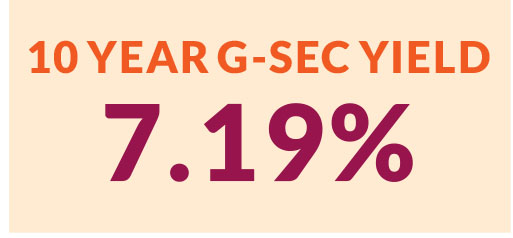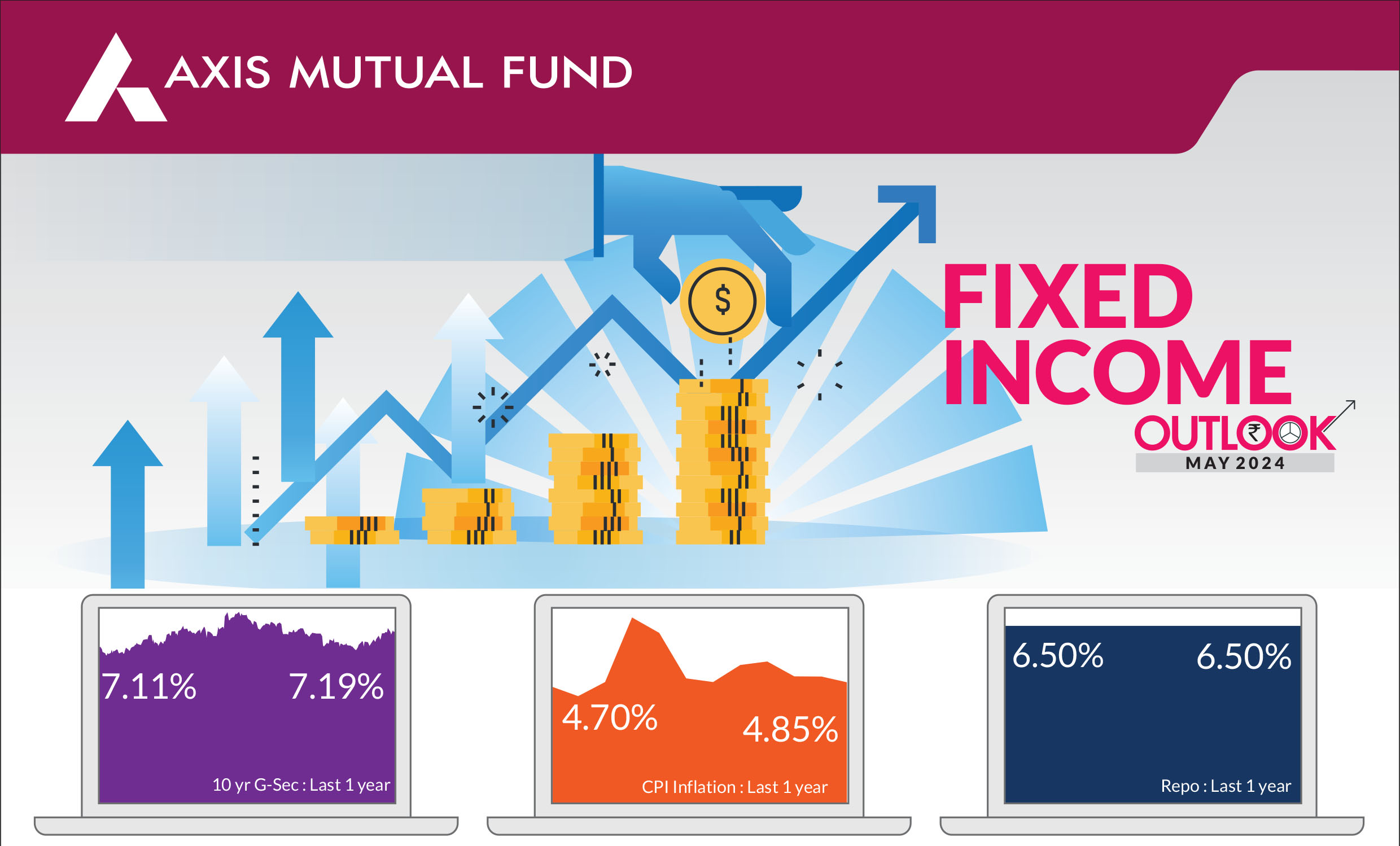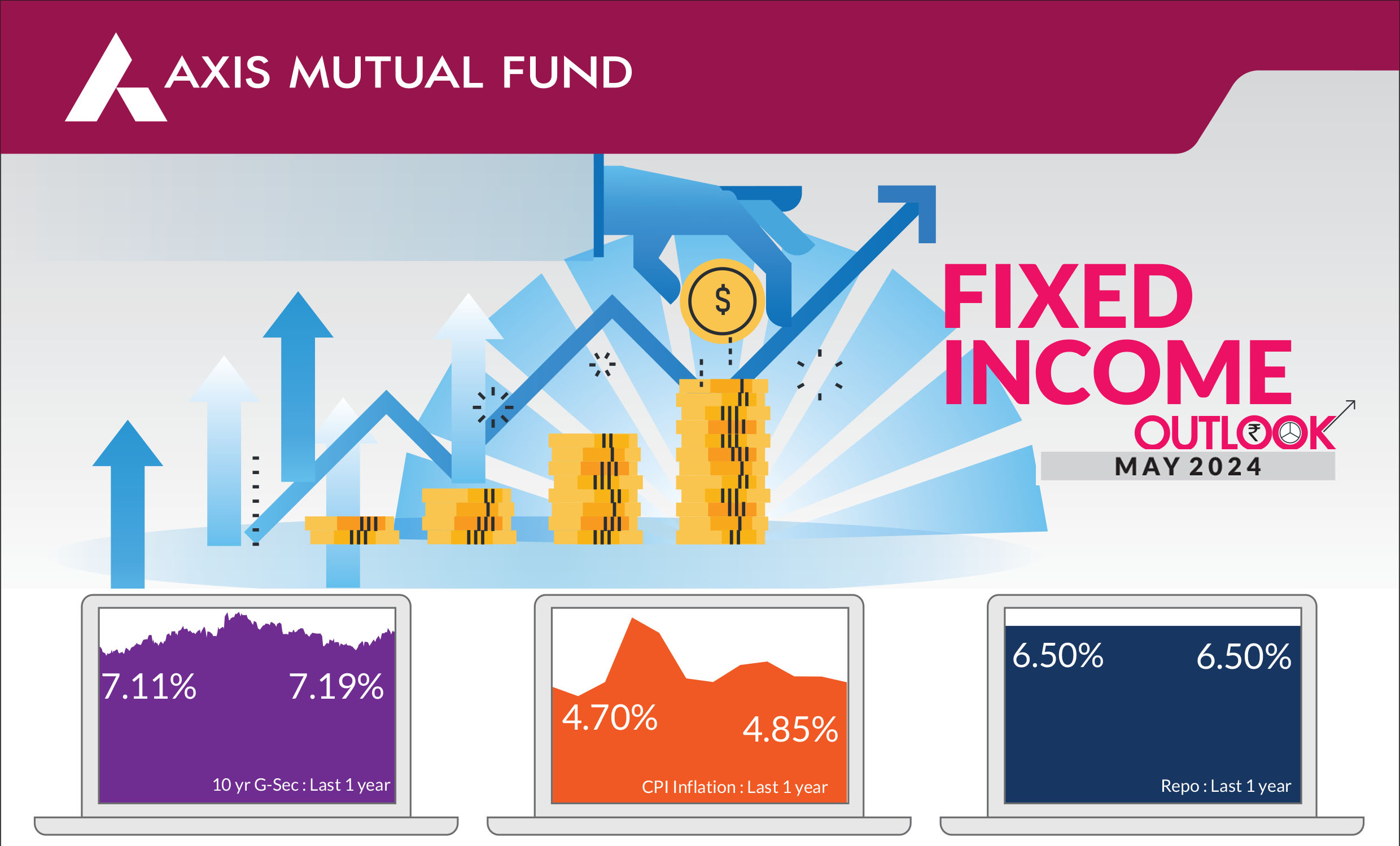•
Expect lower interest rates in
the second half of Fy25.
• Investors should add duration
with every rise in yields, as
yield upside limited.
•
Mix of 10-year duration and
3-5-year duration assets are
best strategies to invest in the
current macro environment.
•
Credits continue to remain
attractive from a risk reward
perspective give the improving
macro fundamentals.
Bond markets globally experienced volatility, influenced by stronger than expected US data and rising geo political tensions. As a result, the yields on US Treasuries rose significantly, closing the month 48 bps higher at 4.68%. Indian government bond yields too mirrored the moves of US Treasuries and rose 14 bps to 7.20%. Foreign Portfolio Investors (FPI) flows were net sellers of government bonds in April to the tune of US$1.3 bn over the month and year to date, cumulative debt inflows amounted to US$5.4 bn.
► Shifting interest rate expectations:
The
macroeconomic indicators from the US have
shown robust performance, particularly in
retail sales and employment numbers in
February-March. Concurrently, headline
inflation experienced an uptick, reaching
3.5% over the month. This led to a significant
increase in the yields of US Treasuries, as the
possibility of interest rate reductions by
June has diminished due to the Federal Reserve's (Fed) statements. Though the Fed
acknowledged "lack of further progress towards its 2% inflation goal in the recent
months," market implied expectations for at least one Fed rate cut this year remained
intact. Initially, the markets had anticipated 5 to 6 rate cuts by the Fed at the start of the
year.
In its April monetary policy meeting, the Fed retained a status quo on interest rates and refrained from mentioning about change in dot plots, but announced plans to reduce the pace of balance sheet drawdowns by US$ 35bn starting 1 June 2024. The central bank still expects the next move to be rate cuts, but as of now, rates can remain unchanged for long. The Fed's comments led markets to believe that its ultra-hawkish stance has been tamed to a cautious one.
In the Eurozone, economic growth appears to have reached its bottom and is poised for an upswing, as suggested by GDP and PMI figures. Although inflation is on a downward trajectory, core services inflation remains somewhat high. Despite this, there is still anticipation for a potential rate cut in the near term. On a separate note, the Reserve Bank of India (RBI) maintained its interest rates during the April policy meeting, adopting a vigilant stance regarding inflation.
In Japan, with the cessation of negative interest rates and yield curve control, attention has shifted to the timing and magnitude of potential rate hikes. Meanwhile, recent data from China has validated the impact of supply-side incentives, indicating stronger GDP growth coupled with increased deflationary pressures. Additionally, the GDP deflator has continued its negative trend for the fourth consecutive quarter.
In its April monetary policy meeting, the Fed retained a status quo on interest rates and refrained from mentioning about change in dot plots, but announced plans to reduce the pace of balance sheet drawdowns by US$ 35bn starting 1 June 2024. The central bank still expects the next move to be rate cuts, but as of now, rates can remain unchanged for long. The Fed's comments led markets to believe that its ultra-hawkish stance has been tamed to a cautious one.
In the Eurozone, economic growth appears to have reached its bottom and is poised for an upswing, as suggested by GDP and PMI figures. Although inflation is on a downward trajectory, core services inflation remains somewhat high. Despite this, there is still anticipation for a potential rate cut in the near term. On a separate note, the Reserve Bank of India (RBI) maintained its interest rates during the April policy meeting, adopting a vigilant stance regarding inflation.
In Japan, with the cessation of negative interest rates and yield curve control, attention has shifted to the timing and magnitude of potential rate hikes. Meanwhile, recent data from China has validated the impact of supply-side incentives, indicating stronger GDP growth coupled with increased deflationary pressures. Additionally, the GDP deflator has continued its negative trend for the fourth consecutive quarter.

► Stable rupee vis a vis emerging market currencies:
Emerging market currencies were
significantly volatile during the month while Indian Rupee exhibited stability and a
lesser fall comparatively. India's falling twin deficits, robust macros and one of the
better growing economies tag has helped the currency to be stable.
► Inflationary pressures gradually declining: CPI moderated to 4.9% in March at 5.1% in February while core CPI declined further to 3.3%. This was led by a slowdown in prices across the board, for both core goods and services, from the previous month's levels. Going forward, a normal monsoon could lead to a downward trajectory in inflation in the second half of 2024.
► Increasing geopolitics drives crude prices higher: Escalating tensions between Israel and Iran which increased in the past few weeks dampened investor sentiments. Overall, commodities saw a significant uptick in prices especially Crude and precious metals due to increasing geopolitical risks. Brent crude crossed $91 in April but ended the month at US$ 87.86. Nonetheless, an inventory overhang led to a notable fall in prices to ~US$ 82.
► Inflationary pressures gradually declining: CPI moderated to 4.9% in March at 5.1% in February while core CPI declined further to 3.3%. This was led by a slowdown in prices across the board, for both core goods and services, from the previous month's levels. Going forward, a normal monsoon could lead to a downward trajectory in inflation in the second half of 2024.
► Increasing geopolitics drives crude prices higher: Escalating tensions between Israel and Iran which increased in the past few weeks dampened investor sentiments. Overall, commodities saw a significant uptick in prices especially Crude and precious metals due to increasing geopolitical risks. Brent crude crossed $91 in April but ended the month at US$ 87.86. Nonetheless, an inventory overhang led to a notable fall in prices to ~US$ 82.
Market view
The US economy has surpassed expectations on economic growth and signs of a slowdown have been deferred. Inflation has been choppy but gradually heading lower. Even though macros are robust, they have taken a back seat and expectations of interest rate cuts by the Fed have shifted to end of year in light of rising geopolitical threats and the run-up in crude prices. Accordingly, we believe that the central banks globally and in India will exercise cautions before lowering interest rates. In line with our view, the RBI upheld interest rates in early April and we expect this stance to continue. Oil prices remain a risk against the backdrop of geopolitical conflicts and if oil prices remain under control, inflation could head further lower over the course of the year.Overall, India is in an extended goldilocks against a backdrop of moderating inflation, higher economic growth and strong external account (falling fiscal and current account deficit and a stable rupee). We remain constructive on rates due to positive demand supply dynamics especially for Indian government bonds due to their inclusion in JP Morgan / Bloomberg Indices. Furthermore, the operative rate has shifted from 6.75% to 6.5% due to ease in banking liquidity and this has led to rally in short term bond yields.
Positioning & Strategy
The fixed income curve is pricing in no rate cuts till March 2025. We have retained our long duration stance across our portfolios within the respective scheme mandates. We do expect the 10-year bond yields to trade in a narrow range of 7.10-7.25% in the near term and to soften to 6.75% over the next few quarters. Investors need to be patient on the rate cut cycle which could be delayed to the second half of FY25.
From a strategy perspective, while the overall call is to play a falling interest rate cycle over the next 6-12 months, markets are likely to see sporadic rate movements. In the current scenario, investors should use the rise in yields to build in duration across their portfolios. With positive demand supply outlook for bonds and improved liquidity stance of RBI, investors could use this opportunity to invest in short to medium term funds with tactical allocation to gilt funds. We maintain a higher allocation to corporate bonds and SDL's due to lower issuance and perceived change in RBI's liquidity stance.
Source: Bloomberg, Axis MF Research.


